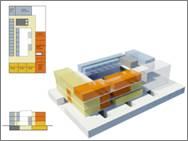Campus Facts
Heritage Preservation
- The downtown academic campus opened in 1909, and was originally 3 Georgian style buildings eventually named Draper, Hawley, and Husted, with 3 additional buildings, Milne, Page, and Richardson, completed in 1929
- The downtown residential campus, Alumni Quadrangle, includes Pierce Hall built in 1935, Sayles Hall built in 1941, Brubacher Hall built in 1951, Alden Hall built in 1958, and Waterbury Hall built in 1959
- The downtown campuses are located approximately one mile from the state capitol
- The uptown campus was designed by Edward Durrell Stone
- There were over 500 original architectural drawings, which would stretch over 1/2 mile if placed side by side
- The site for the uptown campus was originally 360 acres, 292 of which were purchased from the Albany Country Club in 1961
- Groundbreaking of the uptown campus occurred in 1962, with an initial cost of $130 million
- The last of the original buildings completed were in Indigenous Quadrangle in 1973
- The construction of the uptown campus required the removal of over one million cubic yards of earth (the equivalent of over 200 18-wheeler trailers)
- The academic podium originally required 270,000 cubic yards of poured concrete, weighing 560,000 tons (this is less than 2/3 the volume of the Pentagon, which is the largest poured concrete building in the United States)
- There are over 2000 precast columns on the academic podium
- The first building occupied on the uptown campus was Van Rensselaer Hall in Dutch Quadrangle in 1964
- The academic podium first held classes in 1966
- The uptown and downtown campuses have been identified by the New York State Historic Preservation Office as historically significant
Space Mangaement
- The uptown campus is approximately 500 acres, while the downtown is roughly 15 acres
- There is over 5 million gross square feet on the campuses - over 3 million academic and 2 million residential
- The uptown campus has over 130 buildings, while the downtown has 13
- The academic podium deck surface is 934,800 square feet
- The academic podium is one mega structure made up of 13 three-story buildings and three basement structures
- There are over 7,000 parking spaces on the uptown and downtown campuses
- Approximately 8,000 beds in the uptown and downtown dormitories
- Each of the four uptown dormitory quadrangles has eight three-story buildings and one 207' tall 22 story tower
Facilities Planning
- There are nine vehicular entrances to the uptown campus
- There are over 330 emergency blue light phones on campus
- The uptown campus has 12 miles of road
- The Uptown Campus has 16.5 miles of storm sewer pipes and 655 catch basins
- The Uptown Campus has 6.4 miles of sanitary sewer pipes
- The water tower is 18' in diameter, 164' tall, and holds 311,000 gallons of water
- The carillon has 16 speakers and is 249' to the top
- There are over 10,000 windows in the podium buildings
- There are over 6,500 interior doors and 250 exterior doors on the uptown campus
- There are over 14,000 windows in the four uptown dormitory quads
- There are over 7,000 doors in each of the four uptown quads
- There are over 1000 Light Poles on the uptown campus
- Facilities budget comprises roughly 3.5% of the total University budget
- Calculated deferred maintenance is over $1 billion, annual critical maintenance budget of $33 million
- There are over 3,500 trees on the uptown campus
- There are 140 planters on the academic podium
- There are 6 domes on the podium canopy, 3 of which are original and 3 were constructed in 2011
- Four fountains on the uptown campus, along a north-south axis
- The reflecting pool of the main fountain holds 160,000 gallons of water
- There are two formal gardens on the academic podium, each over 2,000 sq ft
- There are 33 outdoor athletic and recreational fields and courts
- Parker Pond is man-made, holds over 6 million gallons of water, goes as deep as 15', collects stormwater runoff, and is used for irrigation throughout the uptown campus
- The Purple Path is three miles long (five kilometers), and runs along the periphery of the uptown campus (currently under construction)

Last updated December 2011







